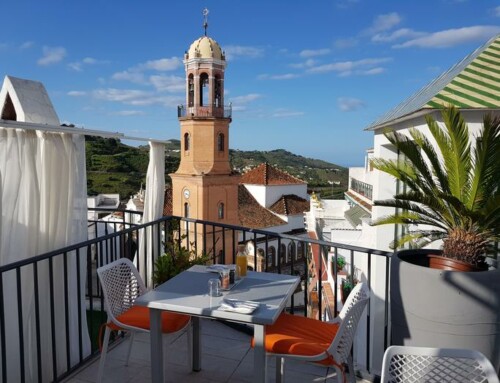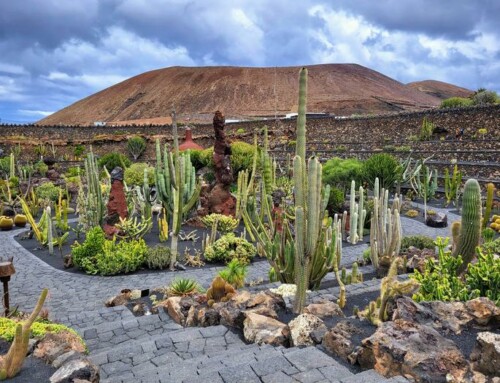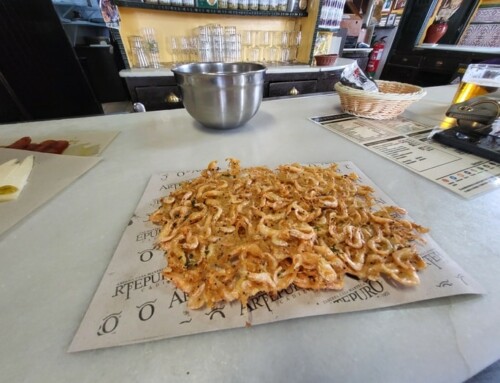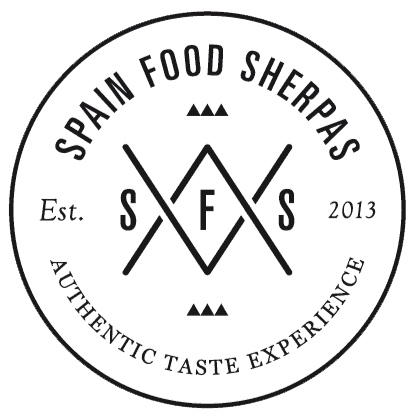Spain is a country with lots of flavour. One of the best ways to enjoy so is by exploring its food markets: traditional places where visitors can find the freshest fruits, vegetables, meats and fishes. Some of the most famous markets include the Boquería in Barcelona, San Miguel in Madrid or the Lonja del Barranco in Seville.
However, in Spain Food Sherpas we would like to approach ten Spanish markets in which tradition rules: markets where neighbours do their daily shopping, places where tradition remains and where local gastronomic secrets may be discovered and, why not, also tasted in one of their small bars where they can cook like no one else. ¡Buen provecho!
1· Santiago · Mercado de Abastos
Scallops, variegated scallops, prawns, barnacles, spider crabs, mussels, Norway lobsters, lobsters… And the best Galician fishes, fruits, meats and vegetables. These are the products that can be found within the historical Plaza de Abastos of Santiago, a mandatory visit for any traveller interested in gastronomy.
It is located in the same place where the original Mercado de la Ciudad (City Market) was inaugurated in 1870: in the heart of Santiago de Compostela, with its narrow streets, stones with lots of stories that await to be told and very close to the famous Cathedral. The market is run as a cooperative and some market gardeners still go there to sell the harvest they collect daily from their gardens; so fresh products are more than guaranteed. This traditional market has been updated thanks to the use of online shopping services, vacuum packing to keep your goods fresh till you get home and you can even hire your own personal shopper to get advice.

Photo: Turismo de Santiago
If you are not from Galicia, this could be the best way to get to know the names of its tasty shellfish. You may also enjoy areas such as Abastos 2.0, which are inside the market and where a weekly menu is prepared with seasonal products; or Mariscomanía, where you can have your groceries cooked if you want to. There are also stalls where you can buy hand-made tins of food, jams, oils and a wide variety of local gourmet products.
2· Cádiz · Mercado Central
In the Mercado Central of Cádiz shrimps are so fresh that they almost seem like they’re jumping around, apparently full of joy, to welcome you. This is one of the most interesting places in the capital of Cádiz: not just due to its almost two centuries of history, but because it is here where the essence of the most southern province of the Iberian Peninsula can be discovered.
You can find within its fifty stalls devoted to seafood massive fillets of swordfish, shellfish with very curious names and fishes that look so good that almost demand to be eaten raw. Not to talk about the incomparable shades of red of the tuna that swims in the waters of the Strait of Gibraltar. You should not miss trying retinto beef, from the cattle which grazes outdoors on lands of Vejer de la Frontera or Tarifa and whose heads of cattle may be watched strolling peacefully around Bolonia beach while you enjoy the sun.
There is also within this Mercado Central a so called Rincón Gastronómico (Gastronomic Space) where you can try Maire -the local beer-, have some fresh juices and milkshakes, taste a wide variety of tapas or discover the Gadisushi, Japanese cuisine mixed with flavours from Cádiz.
And if you feel that this was not enough, you should know that this food market is located in the very centre of Cádiz, very close to places such as the Plaza de las Flores or the beautiful Torre Tavira, where you can find a perfect view of the whole Tacita de plata. La Viña neighbourhood, which is equally traditional and tasty, is also only a few steps from the market: it is a mandatory walk for every visitor of Cádiz.

Photo: Mercado Central de Cádiz
3· Bilbao · Mercado de la Ribera
You will be astonished during your visit to the Mercado de la Ribera for sure: it has more than 10,000 square meters. This fact entails at least three consequences: the first one is that you might get lost. The second one, that you should have enough time to spend hours discovering its products, talking to the shopkeepers and getting to know Basque traditions. And the third one, its measurements make this market the biggest indoor market in Europe. In fact, since 1990 it’s been recognized as the most complete municipal food market by the Guinness World Records.
It was built during the 1930s with very large windows, Art Deco style and latticework which make this place a must when visiting Bilbao. It is a unique place on the bank of Nervión River to chat with people from the city, who are the best experts on its products and their secrets or curiosities. You have plenty of options: the market has three floors and there you can find the best and freshest products of the sea and lands within the Basque Country: meats, fishes, fruits, fresh vegetables, mushrooms, cheeses, wines, flowers, pies, seeds, tinned or pickled food etc. Some of the chefs of one of the best cuisines all over the world -the Basque cuisine- do most of their shopping here. And anyone can do so as since the 70s it is no longer a market for wholesalers.
You can do the shopping via internet, however you would then miss its lively atmosphere, the noise, the smells and colours beneath this huge building. You can taste some of the products you might have discovered in the restaurant La Ribera Bilbao, where apart from the wide gastronomic selection you can find jazz music every evening. Besides, the Mercado de la Ribera is located between the old town of the city (Casco Viejo) and the Bilbao la Vieja neighbourhood, so it is the perfect place to start a walk in any direction to discover the city.

Photo: Mercado de la Ribera, Bilbao
4· Seville · Mercado de Triana
If there is a neighbourhood which represents perfectly Seville, that will be Triana, which is on the bank of the Guadalquivir River. This place is full of history and tradition remains here. The Mercado de Triana is located within the limits of this neighbourhood, just in the heart of Triana next to legendary streets of the capital of Andalusia such as San Jacinto, Betis and Castilla.
The food market is almost two hundred year old, though the original building was built during the 12th century. Within its ground floor, remains of Saint George’s Castle which is of Arabian origin and which was later used as Spanish Inquisition seat during the Middle Ages, can still be found. Going through its corridors is quite an experience. Not just because the wide variety of fruits, vegetables, meats or fishes but also because of the smell of spices, cold meats or many hand-made products.
This is the perfect place to get to know the special character of the neighbourhood and the lifestyle of the Andalusian people through the shopkeepers. This food market also has ten stalls devoted to serve meals which really care about traditional Andalusian cuisine, and other very typical places of Seville’s culture as an abacería (stall where pulses?, oil, vinegar or cod are sold).
The Mercado de Triana also gives you the opportunity to discover its secrets thanks to a guided tour or even putting on an apron and learning some of the typical recipes of the Andalusian cuisine in its cooking school.

Photo: Mercado de Triana, Sevilla
5· Madrid · Mercado de San Fernando
In the Mercado de San Fernando you can buy fresh lettuce and fish, have a small bottle of beer, have that tear on your trousers mended, taste a fresh milkshake, eat Greek Kalamata olives, buy a book, discover the Nikkei cuisine or buy some of the best tinned food in the country. You may even learn traditional recipes in the so called Cocina del Mercado (Market’s Kitchen), which is a place where different people -neighbours, shopkeepers…- elaborate regional and seasonal dishes with products from the market itself.
It is located in the Lavapiés neighbourhood and next to el rastro (an open air flea market). It opened for business in the middle of the 20th century, although it was renovated in the late 90s. Nevertheless, it’s been lately when the shopkeepers themselves have boosted a renovation and updating of the building. This fact has allowed the food market to keep its traditional character combined with up-to-date improvements. That’s the reason why apart from buying fruits, vegetables or fishes, you may also learn how to dance swing, participate in a basketry course or get to know better the world of wines through wine tastings.
Likewise, the market includes gastronomic stalls in which you can find a tasty variety of Greek products, Sushi, ceviche or Argentinean meats. That said, you should not miss the most traditional and castiza proposals from the Barroso bar: a place to taste Spanish omelette, paella, callos (dish made of tripe) and other homemade meals.

Photo: Mercado de San Fernando, Madrid
6· Las Palmas de Gran Canaria · Mercado del Puerto
The Canary Islands do not just have one of the best climate conditions all over the world, but also an interesting gastronomy full of local products. You can find them all in the Mercado del Puerto in Las Palmas de Gran Canaria. It is a traditional space which was built from wrought iron by the end of the 19th century.
From the typical Canary Islands banana to the gofio (meal cooked with shredded wheat or maize). This market is well worth a visit since you can discover Canary Islands products such as the tasty grapes, figs or chickpeas from Lanzarote’s orchards, Palm honey from La Gomera, black potatoes from Tenerife or tropical fruits like papayas, mangos, avocados and custard apples. You can also find the delicious local liqueurs, cheeses with Designation of Origin such as Majorero from Fuerteventura or oils and wines with Designation of Origin too. Not to mention the Atlantic fishes and some local ones such as the claca, the red porgy, the Atlantic wreckfish or the vieja.
It is located in a superb environment: Santa Catalina’s isthmus, which is the narrow strip of land that connects the North of the city with La Isleta, next to Las Canteras beach. Lately, the Mercado del Puerto has also made room for international gastronomy with small restaurants of Italian, Scandinavian, Japanese, American, Basque or Brasilian cuisine. It has also recently gone for a social and cultural touch with several proposals. Now you can even do the weekly shopping while listening to a local DJ’s music. Or you may find stalls where customized bikes or vintage comics from the 80s are sold.

Photo: Mercado del Puerto. Las Palmas de Gran Canaria
7· Barcelona · Santa Caterina
It is currently one of the most famous pictures of Barcelona: the colourful and undulating roof of the Mercado de Santa Caterina. Setting up the roof has been considered one of the most appealing restorations of the Catalonian capital over the last few years and an attraction for visitors.
This traditional market is located in the beautiful neighbourhood of La Ribera, which has been supplied with the freshest products since the 19th century by this market -being the oldest indoor market of the city. Nevertheless, the history of the market goes further back: during the remodelling of the market archaeological remains of the former? nunnery from which it got its name were found. These remains can be currently seen in the basement of the market as part of Barcelona’s Museum of History. All of these features cause this market to be one of the most interesting markets in the city, which has around 40 food markets -some of them very well known as the Boquería, located right in Barcelona’s ramblas.
There are fresh products in Santa Caterina: vegetables, fruits, meats, fishes and a never ending variety of Catalonian products as well as products from other Spanish regions like Galicia or Andalusia. This fact gives the visitor the chance to discover some of the best suggestions from the national gastronomy. There is a restaurant inside -Cuines de Santa Caterina-, which pretends to be a warehouse of gastronomic products and which offers both Catalonian and international food. The market is thus the perfect place to get strength back and, after that, continue visiting the Gothic side of Barcelona through the narrow streets of the nearby Born neighbourhood.

Photo: Mercat Santa Caterina
8· Valencia · Mercado Central
The Mercado Central of Valencia is one of the most appealing buildings in the city. It makes up a beautiful triangle with two monuments as they are the Lonja de la Seda (Silk Fish Market) and the Iglesia de los Santos Juanes (Santos Juanes Church).
This amazing building of Ciutat Vella was inaugurated in the beginning of 1928 and has a modernist character defined by materials like iron, glass or pottery. It has more than 8,000 square meters where around 1,200 stalls are spread. It is one of the biggest markets in Europe specialized in fresh products. Here you can find almost anything: from traditional legume, vegetables, fruits, fishes or meats to more specific products like salted food, offal, tocinería (food made of pork fat), food from grocer’s stores or fowl products.
This space also houses a gastronomic proposal: The Central Bar, whose stove bears the signature of a chef with a Michelin Star: Ricard Camarena. His suggestion is focused on the cero kilometre philosophy: using products near him in his gastronomic proposal. Rumour has it that he was the first one to computerize his sales and to have a home delivery service -which he has since 1996. His website can be visited in English, German, French, Dutch and Italian apart from Spanish and Valencian, which can be considered as a great attraction for tourism.

Photo: Mercado Central de Valencia
9· Huelva · Mercado del Carmen
The Mercado del Carmen of Huelva, which is more than 150 years old, is one of the most distinctive places in Huelva’s capital. This place helped to set up the Carmen neighbourhood, but over the time the market became too small. Nevertheless, at the beginning of the 21st century it underwent a makeover which resulted in its opening in February 2010. It has been a complete makeover: from the outside, this market looks like a modern art museum.
Currently it is not just a place to sell fresh products, but also a new cultural and touristic attraction in the city. You can find some of the best products of the local gastronomy in its really organized stalls. On the one hand, you can find fishes and shellfish from Huelva such as Isla Cristina’s white prawn to begin with and also chocos (a variety of squid), coquinas (a type of clam), smooth clams, mantis prawns, red snappers or red mullets, which are indigenous to this region. And on the other hand, you can find hams and meats from Jabugo and from the rest of the Sierra de Aracena mountain range.
This place also provides the shoppers with magnificent varieties of mushrooms, as appetizing as boletus or Caesar’s mushroom. Likewise, you should not forget to buy a bit of salt from Isla Cristina’s saltworks. And, if what you want is to get a cooked meal, you should pass by any of the five stalls which were turned into small bars. There you will get some of the fresh products from the market.

Photo: Mercado del Carmen de Huelva
10· Málaga · Mercado de Ataranzas
The street where the Mercado de Ataranzas is located used to be a beach not long ago. The Mediterranean Sea used to reach this point and because of that this building was first used as a shipyard during the 14th century. It was built during the Nasrid Dynasty and that is the reason why this building still has an Arabian touch, its main entrance for example. This building has been devoted to different uses over the years -from barracks to a military hospital-, however since the 19th century it has been the main market in Málaga.
Walking through the building is just like going into a gastronomic paradise: it is the perfect place to discover all the delicatessen produced within Malaga’s regions. The citrus fruits from the Guadalhorce Valley, the orchards from Vega de Antequera, the tropical fruits from the Axarquía, the tasty seafood from the Costa del Sol or the cold meats from the Serranía de Ronda mountain range. All of this creates a unique experience that may be turned into a very varied shopping basket to carry home: anchovies, mangos, papayas, tomatoes, artichokes, or malagueña goat cheese all of them produced within the province of Malaga.
Besides, you may also add to your shopping bag indigenous products to Malaga such as lettuce, Alfarnate almonds, aloreñas olives (the only ones with a Designation of Origin) or the morá (purple) carrots cultivated within the municipality of Cuevas Bajas.
We love this market and the local vendors who work there so much, that we´ve featuring it on our Taste of Malaga Food Tour for a while now.

Photo: Spain Food Sherpas
Some of the traditional stalls are now small taverns where you can try all of these fresh products immediately and discover the tasty recipes of Malaga.
SIGN UP FOR OUR NEWSLETTER!

Photo: Mercado Central de Cádiz

Photo: Mercado de la Ribera, Bilbao

Photo: Mercado de Triana, Sevilla

Photo: Mercado de San Fernando, Madrid

Photo: Mercat Santa Caterina

Photo: Turismo de Santiago
Don’t forget to share this post!
Related Articles
↓
Sign up for our Newsletter and get the inside scoop on our favorite recipes,
exploring and devouring Spain and more.



